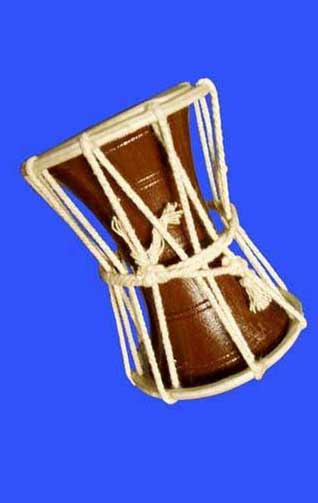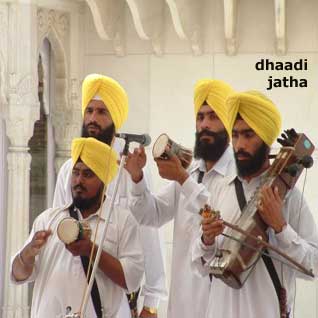Music
The Dhaad Drum Of The Sikh Bards
M. LALITHA & M. NANDINI
We were in Delhi for a concert and decided to visit a friend in Mohali, Punjab. Apart from the routine sightseeing, we listened to some amazing singers who were playing a small drum called the Dhaad.
Shaped like an hour-glass (also called a ‘waisted drum‘), this percussion instrument is unique to Punjab and accompanies Sikh bardic music.
The group of singers who play the drum are known as Dhaadis. They sing folk and traditional songs about valiant soldiers and heroes, drawn from religious and romantic tales, the deeds and teachings of Sikh Gurus and tales of the Sikh tradition.
CHANGE IN THE REPERTOIRE
Guru Hargobind, the Sixth Master, is said to have brought about a change in the Dhaadis’ repertoire from singing the praise of rulers to that of God. The Dhaadis henceforth sang Gurbani (verses from the Scripture, Guru Granth Sahib).
A group of dhaadis (also known as a Dhaadi Jatha) usually consists of one Sarangi performer, two dhaad players and one singer/narrator of the story. They sing together and individually.
The dhaad also accompanies Bhangra performances and fairytale songs for children.
A small percussion instrument, it belongs to the category of the avanaddha vadyas or membranophones. Having a low bass and mellow tone, its body is made of wood from the mango tree, mulberry or ‘sheesham.’ Its two heads are covered with goat skin and are tightened with ropes. This enables the instrument to be held tightly. It is held in one hand and struck on both sides. The pitch can be modified by tightening the cloth that is draped around its waist. The tautness of the skin can be controlled by the performer with one hand to manipulate the sound as he plays it with the other. Closed and open sounds can be produced. The tone is decided by the tightness of the cord.
Hour-glass shaped drums are found in many global music traditions though its construction, usage or playing technique may differ. Other instruments that fall into this category include the udukkai (Tamil Nadu), the subcontinental Damaru, Idakka (Kerala), Urumi (heard in the folk music of Tamil Nadu), Talking Drum (Africa), Janggu (Korean), Jiegu (used in ancient China during the Tang Dynasty), the Japanese Kakko (used in Taiko ensembles) and Gagaku (used in Japanese court music), the Tsuzumi (heard in the Japanese theatrical form Noh, Kabuki and in folk music minyo). Ōtsuzumi (also played in traditional Japanese theatre and folk music) and Yoruban Bata drum (of Nigeria is played during religious functions).
The Udukkai and Dhaad have similar playing techniques yet differ in their social significance.
Unlike the Dhaad, both sides of the Damaru have cords that are knotted and this hand-held drum is played by moving the hand fast in a semi-circular motion so that the knotted cords strike the heads. The dhaad is also adorned with tassels and bells.
The Udukkai is usually connected with the Mariamman temples, the Damaru with the Saivite tradition, the Idakka with the Kerala temples.
The Dhaad is unique to the Sikh bardic tradition.
The authors are musicians in the Carnatic tradition.
[Courtesy: The Hindu newspaper. Edited for sikhchic.com]
January 5, 2018
Conversation about this article
1: Harsharan Kaur (United States), January 07, 2018, 5:44 AM.
Thank you for this informative piece on the dhaad, a small instrument that packs a big punch, but one that is not often written about.




